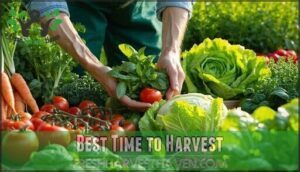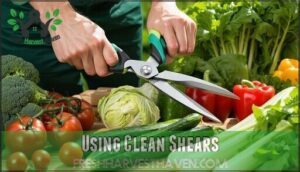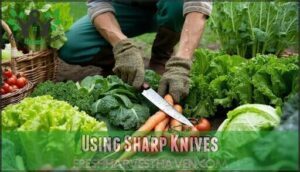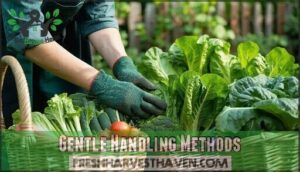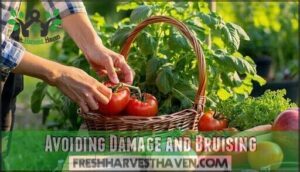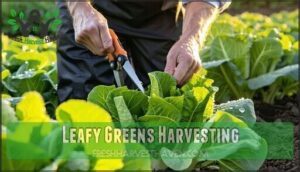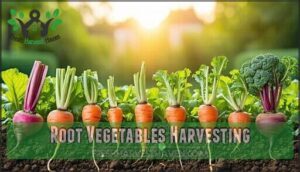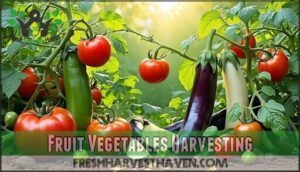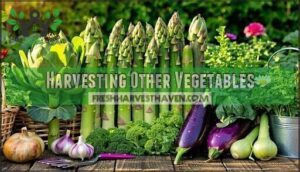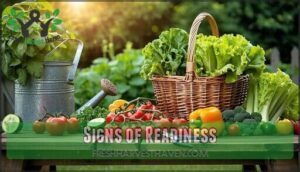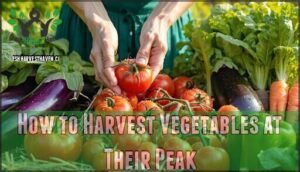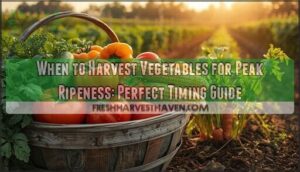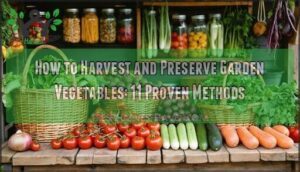This site is supported by our readers. We may earn a commission, at no cost to you, if you purchase through links.
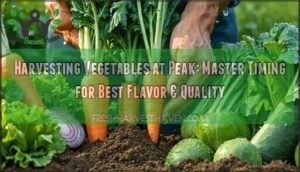 You’ll get peak flavor and nutrition by harvesting vegetables at peak ripeness, but timing’s everything. Check your crops daily in the morning after dew dries – that’s when you’ll capture maximum freshness.
You’ll get peak flavor and nutrition by harvesting vegetables at peak ripeness, but timing’s everything. Check your crops daily in the morning after dew dries – that’s when you’ll capture maximum freshness.
Look for firm texture, proper color, and mature size for your variety. Root vegetables like carrots signal readiness when their tops reach 6+ inches tall, while leafy greens taste best when young and tender.
Use clean, sharp tools and handle gently to avoid bruising. Temperature matters too – morning harvests beat afternoon heat that can stress your produce.
Each vegetable type has unique cues that separate amateur gardeners from harvest masters.
Table Of Contents
- Key Takeaways
- Harvesting at Peak Quality
- Best Time to Harvest
- Harvest Techniques Matter
- Vegetable Specific Guidelines
- Signs of Readiness
- Frequently Asked Questions (FAQs)
- Why are vegetables picked at their peak quality?
- How do you harvest vegetables?
- When is the best time to harvest from a vegetable garden?
- When are commercially-grown vegetables picked?
- What vegetables can you harvest in fall?
- When should you pick vegetables?
- When’s the best time to harvest vegetables?
- What season are root vegetables at their peak?
- How do you know when root vegetables are ready to harvest?
- Should a home gardener harvest a vegetable at its peak quality?
- Conclusion
Key Takeaways
- Harvest in early morning after dew dries – You’ll capture maximum flavor, nutrients, and moisture content when vegetables are at their freshest and coolest.
- Check your garden daily for ripeness cues – Look for proper color, firm texture, and mature size since peak ripeness can change quickly and waiting even one day might mean missing the perfect moment.
- Use clean, sharp tools and gentle handling – You’ll prevent disease spread and bruising by sterilizing tools between plants and supporting vegetables with both hands during harvest.
- Learn each vegetable’s specific readiness signals – You’ll maximize taste and nutrition by recognizing unique indicators like carrot shoulders peeking through soil, glossy eggplant skin, and tomatoes with deep color but firm texture.
Harvesting at Peak Quality
You’ll get the best flavor and nutrition when you harvest your vegetables at their peak ripeness, typically in the early morning when moisture content is highest.
Missing this sweet spot means sacrificing taste, texture, and valuable nutrients that decline rapidly once vegetables pass their prime.
Importance of Peak Ripeness
Harvesting at peak ripeness transforms your garden’s potential into exceptional flavor and nutritional powerhouse vegetables.
When you master harvest timing, you’re releasing maximum vitamin content, prime texture, and extended shelf life that makes every bite worthwhile.
Peak ripeness delivers four critical advantages that separate garden novices from seasoned growers:
- Flavor Enhancement – Sugar and acid balance reaches perfection, creating that burst of intended taste
- Nutrient Retention – Vitamins peak at full maturity, delivering up to 30% more nutritional value
- Peak Freshness – Proper ripening indicators guarantee vegetables maintain quality longer after harvest
- Vegetable Maturity – Complete development of flavor compounds occurs only during the ripening process
Understanding these ripening indicators prevents the disappointment of woody, bitter vegetables while maximizing your garden’s true potential.
Factors Affecting Peak Quality
Beyond understanding ripeness, multiple factors determine your vegetable’s peak quality.
Soil conditions directly influence flavor profiles, while weather impact can accelerate or delay maturity indicators.
Nutrient levels in your soil affect taste intensity and nutritional density.
Your crop varieties selection matters—some cultivars naturally deliver superior flavor at peak harvest time.
Even pest pressure and plant health shape peak moisture and peak flavor development.
Smart harvest timing means considering these background factors alongside visual ripeness cues for ideal results.
Benefits of Harvesting at Peak
Peak harvest timing delivers maximum flavor enhancement and nutrient retention that transforms your garden experience.
When you harvest at peak ripeness, vegetables contain concentrated sugars, vitamins, and minerals that decline rapidly after ideal timing.
This precision approach boosts crop yield by encouraging continued production while ensuring peak freshness lasts longer in storage.
Smart harvest timing during peak vegetable harvest season means tastier meals and healthier nutrition for your family.
Understanding ripeness indicators is vital for achieving the best results in your garden.
Best Time to Harvest
Timing your harvest correctly transforms ordinary vegetables into extraordinary flavors that’ll make your taste buds sing.
You’ll want to check your garden daily once crops start producing, since peak ripeness can change quickly and waiting even one extra day might mean missing that perfect moment of sweetness and tenderness.
Morning Harvesting Benefits
Your garden offers its best treasures when you harvest at dawn.
Morning dew keeps vegetables hydrated overnight, concentrating sugars and nutrients that create peak flavor profiles.
Cool temperatures prevent wilting during gentle picking, while high moisture content guarantees maximum freshness preservation.
Early harvest timing captures vegetables at their ripest state before afternoon heat diminishes quality.
Daily garden visits become rewarding rituals when you understand how vegetable ripening peaks with sunrise.
The crisp morning air makes handling delicate produce easier, protecting your investment until it reaches your kitchen table perfectly preserved, and this is due to the morning dew and the fact that you are harvesting at dawn.
Avoiding Afternoon Heat
Afternoon sun turns your garden into a vegetable torture chamber, draining moisture and wilting even the sturdiest crops within minutes. Heat stress destroys peak flavor and peak moisture faster than you can say "harvest scheduling."
Smart gardeners protect their early morning harvest investment with these sun protection strategies:
- Bring a cooler with ice packs to maintain freshness
- Work systematically through heat-sensitive crops first
- Move harvested produce immediately to shade or refrigeration
Your harvesting vegetables at peak efforts deserve better than afternoon sabotage.
Daily Checks for Ripeness
Through consistent Daily Inspections, you’ll catch vegetables at their flavor peak.
Morning Checks reveal ripening clues before afternoon heat stresses plants.
Fast-growing crops like zucchini need twice-daily Garden Scouting—they can double overnight during peak season.
Daily monitoring increases yields by 30% while preventing 15-20% of produce from becoming overripe within 48 hours.
| Crop Type | Check Frequency | Ripeness Tests |
|---|---|---|
| Fast-growers (zucchini, beans) | Twice daily | Glossy skin, proper size |
| Medium-pace (tomatoes, peppers) | Daily | Color uniformity, slight give |
| Slow-maturing (winter squash) | Every 2-3 days | Hard rind, dry stem |
| Leafy greens (lettuce, spinach) | Daily morning | Crisp texture, vibrant color |
| Root vegetables (carrots, beets) | Every 2 days | Shoulders visible, deep color |
The ripening process accelerates during heat waves, requiring more frequent Fruit Monitoring to maintain peak ripeness and quality.
This is crucial for achieving the best results from your gardening efforts and ensuring that your produce remains at its highest quality peak.
Harvest Techniques Matter
The right tools can make or break your harvest, turning a season of perfect produce into damaged disappointment.
You’ll want clean, sharp instruments and gentle hands to preserve that peak quality you’ve worked so hard to achieve, with sharp instruments being crucial for a successful harvest.
Using Clean Shears
Clean cutting tools make all the difference when harvesting vegetables at peak ripeness.
Your pruning shears and scissors need proper sterilization methods between plants—wipe blades with rubbing alcohol or diluted bleach solution to prevent disease transmission.
Sharp blades create clean cuts that heal quickly, while dull tools crush plant tissue and invite rot.
Here’s why shear maintenance matters:
- Disease prevention – Clean tools stop pathogens from spreading plant to plant
- Faster healing – Sharp, sterile cuts reduce stress and scarring on plants
- Extended harvest – Healthy plants keep producing when properly maintained
- Quality preservation – Clean cutting preserves flavor and extends storage life
Regular pruning tips include cleaning between every few plants and sharpening blades monthly for superior performance.
Understanding optimum harvesting techniques is vital for maximizing crop quality and flavor.
Using Sharp Knives
Beyond just having sharp tools, proper knife handling elevates your harvesting at peak ripeness. A razor-sharp blade creates clean cuts that preserve cellular integrity, reducing bruising and extending shelf life.
When harvest timing strategies matter most, your knife becomes an extension of your hand. Using high-quality sharp kitchen knives is essential for achieving superior results.
- Test sharpness by slicing paper cleanly without tearing edges
- Maintain 20-degree angles during blade maintenance for optimal cutting performance
- Use proper grip with thumb and forefinger controlling the blade spine
- Cut at 45-degree angles through stems to minimize plant tissue damage
- Clean blades between plants to prevent disease transmission and maintain edge safety
Gentle Handling Methods
Your hands are your most important harvest tools – treat them like precision instruments.
Support the plant with one hand while using gentle picking motions with the other to prevent stem damage.
Choose appropriate tool selection based on crop type: scissors for delicate herbs, pruners for tough stems, or bare hands for soft fruits.
This crop handling approach maintains peak ripeness by avoiding cellular damage that accelerates decay.
Master these handling methods through practice – your vegetables will reward you with extended freshness and superior flavor retention.
Wearing gardening gloves properly can also protect your hands during harvesting, ensuring extended freshness and superior flavor retention with proper care.
Avoiding Damage and Bruising
Bruising represents the enemy of quality produce, turning your garden’s treasures into disappointing kitchen casualties. When harvesting vegetables at peak ripeness, your soft touch makes all the difference between restaurant-quality results and compost bin failures.
Handle your vegetables like delicate treasures—each bruise steals a moment of freshness and flavor from your harvest.
Proper damage control starts with gentle picking techniques and appropriate harvest tools. Your fingertips should test ripeness without applying pressure, while clean shears prevent tears that invite decay.
- Use shallow containers to prevent crushing bottom layers during collection
- Select harvest tools with sharp, clean blades to make precise cuts
- Support heavy fruits like melons and squash with both hands while detaching
- Avoid dropping or tossing vegetables into containers, even from short distances
- Check your grip pressure—firm enough to secure, gentle enough to protect
Crop protection extends beyond the garden into storage. Each gentle handling moment preserves cellular integrity, maintaining peak flavor and extending shelf life for your carefully tended harvest.
Vegetable Specific Guidelines
Each vegetable has its own harvest timeline and visual cues that signal peak readiness.
Learning these specific indicators will help you capture ideal flavor, texture, and nutritional value from your garden.
Leafy Greens Harvesting
Leafy Greens thrive with proper timing and technique.
Harvest lettuce when leaves reach 4-6 inches, spinach before flowering, and kale at 6-8 inches for maximum tenderness.
Use sharp scissors for clean cuts, taking outer leaves first to encourage regrowth.
Morning harvesting at peak guarantees maximum crispness and nutrient retention, giving you restaurant-quality greens straight from your garden.
Root Vegetables Harvesting
Underground treasures reveal their secrets through subtle signals that experienced gardeners learn to read.
Root crops reach peak harvest season when their tops show specific maturity signs, typically appearing 60-80 days after planting for most varieties.
- Carrot Harvesting: Orange shoulders peeking through soil indicate readiness; harvest timing for ideal freshness occurs when roots reach finger-thickness
- Beet Timing: Golf ball-sized bulbs with vibrant greens signal perfect ripeness; don’t wait too long or they’ll turn woody
- Radish Care: Quick 30-day turnaround means daily checks prevent overgrowth and bitter flavors in these speedy root crops
- Potato Yield: Flowering tops followed by dying foliage marks the perfect window for maximum tuber development and storage quality
Understanding proper root vegetable harvesting techniques is vital for achieving the best flavor and quality in your crops.
Fruit Vegetables Harvesting
Perfect Fruit Selection starts with recognizing peak ripeness in your fruiting vegetables.
Harvest tomatoes when fully colored but firm—they’ll continue ripening off the vine. Cut eggplants at 4-6 inches with glossy, unwrinkled skin using sharp Harvest Tools.
Crop Monitoring reveals peppers are ready when they reach full color, though green ones work too. Cucumbers taste best at 6-8 inches before seeds harden.
Summer squash should be picked young at 6-8 inches for maximum flavor maximization—harvesting at peak guarantees tender texture and prevents woody development.
Harvesting Other Vegetables
The specialty vegetables in your garden deserve attention beyond the usual suspects.
You’ll master harvesting other vegetables when you recognize their unique vegetable maturity signs. Artichokes need harvesting techniques that capture buds at 3 inches diameter with tight closure.
Asparagus spears reach peak ripeness at 6-8 inches with closed tips—snap them confidently at soil level using sharp garden tools. Garlic’s ready when foliage flops over, typically after proper soil preparation and crop rotation.
Eggplants show vegetable harvest peak quality with glossy, firm skin at 4-6 inches diameter. These specialty crops respond well to consistent irrigation methods and benefit from composting techniques that enhance their distinctive flavors when harvested at the best maturity.
Effective vegetable harvesting requires the right harvest tools to minimize damage and guarantee quality.
Signs of Readiness
Knowing when your vegetables reach peak ripeness transforms your harvest from good to exceptional.
You’ll rely on specific visual, tactile, and sometimes aromatic cues that signal each vegetable has reached its prime flavor and nutritional peak.
Color Changes and Texture
Master the art of reading ripeness through color shifts and vegetable texture—your garden’s built-in quality control system.
Watch tomatoes transform from green to deep red as lycopene peaks, while bell peppers develop vibrant hues signaling maximum vitamin content.
Skin firmness reveals maturity signs: eggplants display glossy sheens when ready, cucumbers maintain crisp bumpy surfaces, and carrots feel smooth without woody tissue density.
Trust gentle pressure tests—ripe produce yields slightly while staying firm.
Dull colors or soft spots indicate you’ve missed the peak ripeness window.
These ripening indicators guide perfect timing for maximum fruit ripening success.
Size and Shape Indicators
Beyond color changes, you’ll want to master sizing techniques to determine mature size and peak ripeness. Shape factors and visual signs work together as reliable indicators across different growth stages.
Most vegetables reach ideal dimensions well before maximum size – bigger isn’t always better! You’ll get sweeter carrots at 1-1.5 inches diameter, while oversized ones turn woody.
Here’s your sizing roadmap:
- Cucumbers: Harvest slicing varieties at 6-8 inches when firm and uniform, before seeds harden
- Zucchini: Pick at 6-8 inches with smooth, glossy skin – daily checks prevent baseball bat-sized surprises
- Root vegetables: Look for carrot tops peeking through soil; beet greens reaching 6+ inches signal readiness below
Understanding fruit ripening processes can also inform your approach to harvesting vegetables. Remember, you’re aiming for that sweet spot where size meets quality, not wrestling with oversized vegetables that’ve lost their flavor.
Smell and Taste Tests
Your nose and taste buds reveal more about peak ripeness than any visual cue.
Trust your senses—they’re your garden’s most reliable harvest timers.
Conduct sensory tests by sampling small pieces to evaluate flavor profiles and texture development. Aroma checks tell the story—ripe melons release sweet, fragrant odors while tomatoes develop earthy, robust scents.
Taste panels confirm readiness through flavor enhancement and nutritional value peaks.
Trust your senses for peak freshness determination through careful odor analysis. Your senses reveal more about peak ripeness than any visual cue, and sensory tests can help evaluate flavor profiles.
Visual Cues for Harvesting
Your garden’s visual cues reveal perfect harvest timing through multiple indicators.
Peak ripeness shows through vibrant color signs—tomatoes displaying deep crimson hues and peppers reaching their true colors. Texture tests matter equally; corn husks feel papery while cucumber skin stays smooth and glossy.
Here are five key visual harvest signs to watch:
- Color transformation – vegetables reach their signature mature hues
- Shape indicators – uniform roundness in cabbages and straight carrots
- Size checks – zucchini at 6-8 inches, not baseball-bat proportions
- Surface texture – glossy eggplant skin versus dull, overripe appearance
- Peak moisture content visible through plump, firm vegetables.
These ripening stages guide your harvest decisions for ideal flavor and nutrition.
Frequently Asked Questions (FAQs)
Why are vegetables picked at their peak quality?
You’ll capture maximum flavor concentration, highest nutrient density, and prime texture when vegetables reach full maturity. Peak timing guarantees you’re getting the sweetest, most tender produce possible.
How do you harvest vegetables?
Use sharp, clean tools to cut vegetables at their stems or bases.
Harvest in early morning after dew dries, handling gently to avoid bruising.
Check daily for peak ripeness indicators like proper color, size, and firmness.
When is the best time to harvest from a vegetable garden?
While rushed mornings tempt you to grab whatever’s available, timing transforms ordinary vegetables into extraordinary harvests.
You’ll achieve peak flavor by harvesting in early morning after dew dries, when vegetables retain maximum moisture and nutrients for superior taste.
When are commercially-grown vegetables picked?
Commercial farms harvest vegetables based on shipping schedules and shelf life rather than peak ripeness.
Fruits often get picked before full maturity to withstand transportation, prioritizing durability over flavor for long-distance distribution to supermarkets nationwide, which affects the overall flavor.
What vegetables can you harvest in fall?
Fall’s garden treasure chest opens wide when you harvest carrots, beets, potatoes, winter squash, Brussels sprouts, cabbage, turnips, parsnips, and kale. These cool-season champions actually sweeten after frost kisses them.
When should you pick vegetables?
Pick vegetables in early morning after dew dries for peak freshness and flavor.
Harvest when they’re firm, properly colored, and at mature size—but don’t wait too long, as smaller often tastes better than oversized.
When’s the best time to harvest vegetables?
You’ll get the best flavor and nutrients by harvesting vegetables early morning after dew dries.
Most crops taste sweetest when picked at peak ripeness—firm, fully colored, and proper size for their variety.
What season are root vegetables at their peak?
Root vegetables hit their sweet spot during late fall, when cooler temperatures trigger starches to convert into sugars.
You’ll taste the difference—carrots become candy-sweet, and beets develop their signature earthiness after frost kisses them.
How do you know when root vegetables are ready to harvest?
You’ll strike gold when root vegetables’ tops reach 6+ inches tall and you can see the mature root shoulders peeking through soil.
Carrots and beets are ready when roots achieve proper diameter and color.
Should a home gardener harvest a vegetable at its peak quality?
You should absolutely harvest vegetables at their peak quality for maximum flavor, nutrition, and tenderness. Peak timing delivers the best taste and highest vitamin content before quality declines.
Conclusion
The proof is in the pudding – harvesting vegetables at peak ripeness transforms your garden’s potential into exceptional flavor and nutrition.
You’ll master this essential skill by combining daily observation with proper timing and technique.
Morning harvests using clean tools protect your crops’ quality while gentle handling preserves their integrity.
Each vegetable speaks its own language of readiness through color, texture, and size.
Your commitment to harvesting vegetables at peak quality separates good gardeners from great ones, delivering superior taste and maximum nutritional value to your table, which is the key to achieving exceptional flavor.

